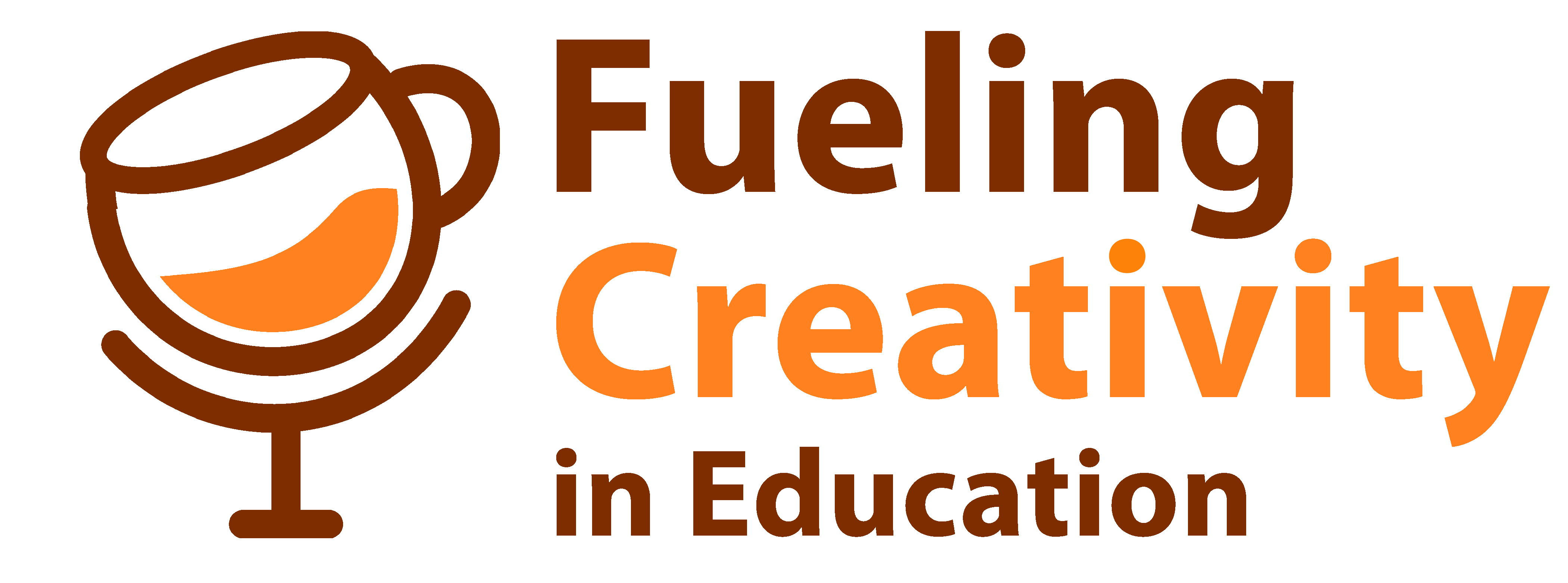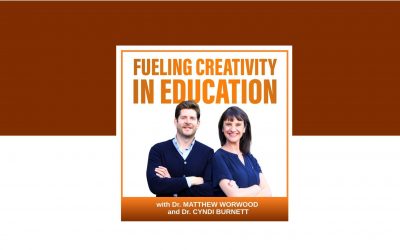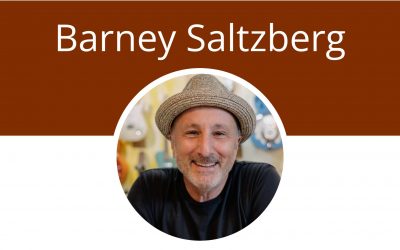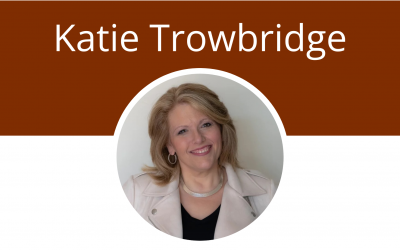LISTEN & LEARN SERIES
The Creative Brain: A Conversation with Dr. Anna Abraham
– Dr. Anna Abraham
Episode Transcription
The Creative Brain: A Conversation with Dr. Anna Abraham
Hello and welcome to the Fueling Creativity and Education podcast.
Matthew Worwood:
It’s summer break here in the US and that means it’s time for another Listen and Learn series.
Cyndi Burnett:
And this series features bite sized episodes designed to support some professional development during the holidays.
Matthew Worwood:
Now, as scholar practitioners can, Cindy and I do see the summer as a chance to recharge and catch up on new ideas and research.
Cyndi Burnett:
So Matt and I put together a list and we reached out to some of our past guests who have recently published books and invited them back to talk briefly about their latest work.
Matthew Worwood:
And if you’re a regular listener to the show and listened to one of our Listen and Learn series before, you’ll know that these off season episodes are short and focused. We asked just three questions about their new book, providing a perfect way to stay inspired while still making time for at rest and family.
Cyndi Burnett:
So whether you’re a new or regular listener, be sure to follow us on your favorite podcast platform and enjoy this special summer edition of Fueling Creativity and Education.
Matthew Worwood:
So let’s begin.
Cyndi Burnett:
Today we welcome back to the show Dr. Anna Abraham. And Dr. Abraham is the Epaul Torrance professor and the Director of the Torrance center of Creativity and talent development at UGA’s Mary Frances early College of Education. Way back when Matt and I did season three, Anna joined us for a double espresso on neuroscience and creativity which we will link to in our show Notes. Today she will be talking about her new book, the Creative Myths and Truths. Anna, welcome back. It’s great to have you again.
Dr. Anna Abraham:
Always good to be with you guys. Thank you for having me.
Matthew Worwood:
All right, so our first question in this Listen and Learn series, Anna, about your book is just for you to give us a 60 second pitch about it.
Dr. Anna Abraham:
Okay. So the book the Creative Myths and Truths explores what I call myth truths throughout the book. So I don’t want to take a judgment on whether they’re myths and truths. I want us to everyone to the reader to explore it with me. So the book explores seven myth truths about the creative brain and it starts with perhaps the one everyone wants to know about, which is the creative right brain is the first chapter. The second myth is the madness and creativity link. The third is the link between psychedelic drugs and creativity. The fourth focuses on atypical brains and creativity because there’s a lot of literature in the neuroscience on how certain types of brain damage lead to an increase in creativity.
Dr. Anna Abraham:
The fifth is on intelligence and creativity, one of the age old questions in creativity. The sixth is on dopamine and creativity because you Know, dopamine being the buzzword it is, gets used in a lot of contexts, including creativity. And the final one is what I call a myth in the making, the default mode network in creativity. So the book explores, is a kind of archival trawl through these seven myth truths and it focuses on how it started, how it gets propagated, and how they get entrenched in our literature and our understanding about the creative brain.
Matthew Worwood:
Now you kind of covered this and I think the book ultimately covers this. But our second question is, what’s a misconception about your topic that your book breaks open? I am interested. I know a lot of teachers talk about right brain, left brain. So if you were looking for a little bit more direction, maybe expand a little bit more on that. But if you’ve got another misconception you haven’t referenced.
Dr. Anna Abraham:
So I would start with the general picture first. The general picture across all seven myth truths that I focus on is that every single one of them has a kernel of truth. Every single one of them. It’s just that in the telling of the tale and how it gets spread that things get twisted and stretched to a point where it’s just too simple to be true in that form. So this is true of all of them. So let’s take the creative right brain myth truth. It was born of a certain time when the left brain was getting all the press right because we started to discover through the neuroscientific techniques these the amazing capacities of our left brain. So it was sort of like where the focus is mainly language.
Dr. Anna Abraham:
And since we think of ourselves as a very language that most of our. Let me put it this way, the idea that language is central to what we do as human beings. And so this part of the brain that seems to do a lot in terms of linguistic functions, that it’s so lateralized, meant that the left brain was sort of emphasized in terms of its importance in all aspects of sort of rational, goal directed, intentional aspects of thinking. And so the right hemisphere got relegated a lot of functions that were just sort of like, well, the opposite without really any proof for it. And so the right creative brain idea came around to say it’s not just for creativity. It’s not just that the left brain is important. The right brain is really, really the right hemisphere plays a key role. So if you look at the early proponents, they’ve always emphasized that both emphasis are involved.
Dr. Anna Abraham:
But because it was so new in drawing attention to the right hemisphere, what became propagated over time is that the right hemisphere is the more important and then the only place for creativity. So they emphasized from the start something that was true, which is like, hey, hey, hey, this neglected part is super important for creativity. And it ended up being, oh, the right brain is the creative brain. And now of course, the right creative brain idea, I think serves as a great metaphor because it’s almost like when you tell people, you know, we want to, you know, we want to have a more right brain curriculum, they instantly understand what you mean. So it almost doesn’t matter that it’s right or wrong from a scientific standpoint, it serves a valuable role in our daily discourse to get things done, to affect change at the level of policy and so on, because it’s so entrenched in the way we think that we can actually use it to our advantage when we want to promote things about creativity, especially at the level of curriculum overhaul and change.
Matthew Worwood:
And if you don’t mind, and this is a short episode, but here’s a brand new myth, truth that I have developed is that when I’m sleeping, if I’m sleeping on my left brain, left side, my brain sometimes is really, really active, you know, and I can’t calm down. I can’t calm down. But when I sleep on my right side, I automatically sometimes feel like I can do the whole like counting sheep and focus a little bit more. So what’s happening there? Am I putting too much pressure on my right brain or left brain? And just so we know, obviously I’m joking around here, but I am curious about that because I do feel like I’m active, really active one side and less active on the other side at 2 o’cl in the morning.
Dr. Anna Abraham:
Yeah, I think you’ve divulged too much there, Matthew. But okay, let’s take, let’s take it and go with it. Right now you’re speaking about things that are lateralized. And this is a really well known finding, not just among humans, but across animal species as well, that we all show preferences in the way that we prefer one limb or the other, one side over the other and so on. So this is in. You see it in birds, you see it in horses, you see it in all species. My PhD advisor did a lot of work on lateralization. That’s why I was kind of accepted into his lab.
Dr. Anna Abraham:
He mainly focused on animal cognition, but the whole thing was why are we lateralized? Is there a systematic sense of it? And he did this great paper a long time ago in Nature, one of the biggest journals in the world, where he talked about the asymmetries of kissing. He noticed when he was sitting really bored in every week he was at an airport and he would look at it and look at people greeting each other at airports. And he would note where their heads turning when they’re trying to kiss. And he noted that there’s an asymmetry in general that people prefer to tilt their heads towards the right. Okay. Than the left. And he ended his data set was like a little. A little card in his wallet where he did little tally marks.
Dr. Anna Abraham:
So this became a nature paper. Right. But essentially what he linked it to was almost from an evolutionary perspective that right from when we’re in mother’s wombs. In his case, he was looking at chick data because there’s a lot of work on eggs and how chicks essentially, while they’re developing, one side gets more innovation. I forget which eye it is. I should remember. But as the chick is developing, one eye is closer to the shell, but the other eye is this way. And it gets more innovation.
Dr. Anna Abraham:
It starts to develop that the hemisphere that receives that light. Innovation starts to develop in ways. In the way that the dark one does not. Right. And of course it influences everything about once a chick gets out. So if I would say in your case, there must be something about the comfort with which you have learned over time to lie on a certain side. And I have the same problem. I can’t.
Dr. Anna Abraham:
There has a certain way that I have to lie in order to feel relaxed. If you feel relaxed, if you looked at your brain wave activities, there’s going to be certain types of patterning that fits with that relaxed pattern. Alpha activity will change. You’ll be getting into what’s called a hypnagogic state, which is ideal for creative ideation. People as eminent as Thomas Edison have known that. So he actually used that in his techniques, by the way. He would sit in a chair with a really heavy bell in his hand. And as he fell asleep sitting down, he would, you know, you lose muscle control.
Dr. Anna Abraham:
It drops down. And he would wake up and then write down all his thoughts then. So he used that sense of feeling relaxed, having this hyper associative light stage in order to channel his creativity to coming up with lots and lots of ideas. So we know there’s something about feeling relaxed, feeling at ease, feeling loosened up, that almost releases the static in your brain in terms of your associative networks that might be conducive to your creativity more than others. So for you it might be about the trigger point is how you lie down. That something about the musculature enables you or doesn’t or constrains you.
Matthew Worwood:
I love it. And we’re seeing these myth truths.
Dr. Anna Abraham:
Is that a satisfying.
Matthew Worwood:
Yeah, I loved it because one, I felt like you’re comparing me to Thomas Edison and then the other part of it was, was the fact that I’m developing my own myth truth. So I love it. All right, our final one is what is one concrete or practical thing your book can teach others?
Dr. Anna Abraham:
The practical thing from the book, and I think I explore this greatly in the afterword, the sort of synthesis that comes from all the chapters and I would say the one take home message is that most of these myths that come to be propagated come about because of the way our brains have evolved. And we have evolved as a species to like stories, right? We like to make sense of what’s going on. If we see something, we are immediately coming up with explanations for why that is. So, you know, you’re driving back home and a car has stalled instantly has nothing to do with us, but instantly we’re curious about it. And the more information we have. Oh, an accident. Oh no, it wasn’t an accident. Looks like someone just been pulled over.
Dr. Anna Abraham:
Oh, that’s what we do, that’s what the brain is there, come up with explanations and we try to explain it. We want explanations for everything that we have and that we see around us these marvelous feats of creativity. Whether it’s you see it in, you know, five year old Mozart or in 70 year old grandma Moses who started a pain, then you know, so. Or when you see suddenly your child have this super incredible interest in something that they’ve never shown interested in before, or where you see creative techniques being able to improve cognitive function in older adults. There’s something about that we want to explain. And a lot of the time my explanations are only as good as what we know about it. And we reach out and when it comes to something magical, we tend to favor more magical explanations. One thing that we can’t do with it, if I say it’s wrong, what you know about the right brain is wrong.
Dr. Anna Abraham:
If you say the creative brain, let’s say the creative part of your brain is not just the right hemisphere. It’s too simple to say that it’s not satisfying as an explanation to be left with a void, to be left with nothing. So people will link, will steer towards explanations that are fun or interesting or seem to make sense in some way more than sort of sit there with this gray void. I don’t really know. And that’s the reason why it’s very hard to dispel them. Because unless you have a great competing explanation, you’re not going to dislodge them. And that’s what I think is the take home message of the book is that we must understand that there’s some part of our mind that is in effect pushing us towards simple, easy explanations because it feels like, oh, I get it, I understand it. That’s such a powerful feeling.
Dr. Anna Abraham:
And sometimes we can be completely off track, but our minds won’t let us kind of recognize or realize or accept it unless we find something else that we find somehow that, oh, I like this, you know, I like this explanation. I don’t know about you, but I see this even in class when we talk about things like the creativity definition. A lot of the students like, well, I don’t like this definition, so I’m not going to accept it. I think, well, I’m not sure it matters whether you like it or not, but it comes from a place of if I, if it doesn’t resonate with me in some way, I can’t sit with, no, this is not okay. I’d rather go with something that’s less good as long as it feels somehow true. Feels true to me. And that’s this, this narrative, the storytelling nature of our, of our minds that we need, we want explanations. We don’t want to think that we don’t know.
Dr. Anna Abraham:
That’s, that’s not fun to deal with.
Cyndi Burnett:
And that makes so much sense. Even before you were, we were waiting for you, Anna. We were talking about someone who just unfollowed me on LinkedIn and we started crafting a whole story around the potential reasons why this might have happened. And in all honesty, I think this person could never have been connected with me to begin with. Not, you know, this whole scenario that we created. So I think that’s both humorous and really interesting given this was a topic while we were waiting for you to join the call.
Dr. Anna Abraham:
That’s cool.
Cyndi Burnett:
I am so grateful for you sharing those insights. And about your book. Is it available in Kindle?
Dr. Anna Abraham:
Audible, not an audible. I don’t think they’ve made an audiobook out of it yet, but I think it is in Kindle.
Matthew Worwood:
It is in Kindle. It is in Kindle.
Cyndi Burnett:
It’s in Kindle.
Dr. Anna Abraham:
It wasn’t available right at the start in Kindle, but I think by now it has been made available.
Cyndi Burnett:
Great.
Matthew Worwood:
It is.
Cyndi Burnett:
Well, we hope you enjoyed the summer 2025 listen and learn episode. Please visit our website which provides a full list of the books we’ve covered during the series with links to the authors websites and links to where you can purchase their books online. You can access the page@foldingcreativitypodcast.com summerreading2025 and.
Matthew Worwood:
We are still booking guests for season 11 of the podcast. So if you have any ideas on researchers or practitioners, or perhaps ideas on topics you’d like us to cover during that season, please reach out@ideasuelingcreativitypodcast.com My name is Dr. Matthew Wortwood.
Cyndi Burnett:
And my name is Dr. Cindy Burnett. This episode was made possible thanks to our sponsor, Curiosity to It.
In this special summer Listen and Learn episode of the Fueling Creativity in Education Podcast, hosts Cyndi Burnett and Matthew Worwood welcome back Dr. Anna Abraham, the E. Paul Torrance Professor and Director of the Torrance Center for Creativity and Talent Development at UGA. Dr. Abraham introduces her new book, The Creative Myths and Truths, which explores seven enduring myths—or “myth truths”—about the creative brain.
The conversation unpacks popular misconceptions, such as the oversimplified notion of the “creative right brain,” the perceived link between creativity and madness, and the influence of dopamine, intelligence, psychedelics, and even brain injuries on creative thinking. Dr. Abraham explains that while these ideas often contain a kernel of truth, they are frequently exaggerated or distorted—especially in educational settings.
This episode is essential listening for educators passionate about Creative Teaching and teaching creativity in meaningful ways. Dr. Abraham emphasizes the importance of moving beyond appealing but inaccurate narratives and instead grounding classroom practice in scientific research. She offers practical strategies for those looking to cultivate creativity in education, including how to use accessible language while still honoring the complexity of the science.
Be sure to check out the episode for thought-provoking perspectives, and visit the show’s summer reading list for more resources—including where to find Dr. Abraham’s book in Kindle format.
Episode Debrief
Collection Episodes
Developing Talent for Activism: Transformational Giftedness and Animal Justice
Listen & Learn Developing Talent for Activism: Transformational Giftedness and Animal Justice“Instead of telling somebody, here's what you need to believe about animals, She gives him information about animals, Here's what study show about how animals behave, and...
Just a Banana and The Rabbit’s Feat: A Conversation with Children’s Book Author Barney Saltzberg
LISTEN & LEARN Just a Banana and The Rabbit’s Feat: A Conversation with Children's Book Author Barney Saltzberg“ And then I came up with an idea called Imagine Art. And it was finding art in cracks in the sidewalk, peeled paint, things like that. And when I was...
Deeper Thinking in the Classroom: A Conversation with Katie Trowbridge on Teaching Creativity
LISTEN & LEARN Deeper Thinking in the Classroom: A Conversation with Katie Trowbridge on Teaching Creativity “ the Deeper Thinking in the Classroom book is all about how to get students to three think in creative critical ways, how to get them to be connected. And...
Podcast Sponsor

We are thrilled to partner with Curiosity 2 Create as our sponsor, a company that shares our commitment to fostering creativity in education. Curiosity 2 Create empowers educators through professional development and community support, helping them integrate interactive, creative thinking approaches into their classrooms. By moving beyond traditional lecture-based methods, they help teachers create dynamic learning environments that enhance student engagement, improve academic performance, and support teacher retention. With a focus on collaborative learning and exploration, Curiosity 2 Create is transforming classrooms into spaces where students thrive through continuous engagement and growth.








